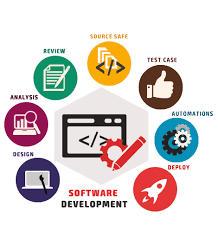Unlocking Success: The Role of IT Infrastructure Consulting Companies in Modern Business
The Role of IT Infrastructure Consulting Companies in Today’s Business Landscape
In the fast-paced digital age, businesses rely heavily on their IT infrastructure to operate efficiently and stay competitive. This is where IT infrastructure consulting companies play a crucial role. These specialized firms provide expert guidance and support to organizations looking to optimize their technology systems and processes.
Services Offered by IT Infrastructure Consulting Companies
IT infrastructure consulting companies offer a wide range of services tailored to meet the unique needs of each client. Some common services include:
- Assessment and audit of existing IT infrastructure
- Design and implementation of new systems and networks
- Cloud computing solutions and migration services
- Network security assessments and enhancements
- Disaster recovery planning and implementation
- IT project management and support
The Benefits of Engaging an IT Infrastructure Consulting Company
By partnering with an IT infrastructure consulting company, businesses can benefit in various ways:
- Expertise: Consultants bring specialized knowledge and experience to address complex IT challenges.
- Cost-Effectiveness: Outsourcing IT infrastructure consulting can be more cost-effective than maintaining an in-house team.
- Efficiency: Consultants can streamline processes, improve system performance, and enhance overall operational efficiency.
- Scalability: Consulting firms can help businesses scale their technology infrastructure as needed to support growth.
The Future of IT Infrastructure Consulting
As technology continues to evolve rapidly, the role of IT infrastructure consulting companies will become even more critical. These firms will need to stay abreast of emerging technologies such as artificial intelligence, IoT, and blockchain to provide cutting-edge solutions to their clients.
In conclusion, IT infrastructure consulting companies play a vital role in helping businesses navigate the complexities of modern technology. By leveraging their expertise and services, organizations can build robust, secure, and scalable IT infrastructures that drive success in today’s digital world.
8 Essential Tips for Effective IT Infrastructure Consulting
- Understand the client’s business needs and goals before proposing solutions.
- Stay updated with the latest technology trends and advancements.
- Build strong relationships with vendors to offer diverse solutions to clients.
- Provide personalized recommendations tailored to each client’s specific requirements.
- Ensure scalability and flexibility in all proposed IT infrastructure solutions.
- Prioritize cybersecurity measures to protect client data and systems.
- Offer ongoing support and maintenance services post-implementation.
- Regularly assess and optimize IT infrastructure for improved performance.
Understand the client’s business needs and goals before proposing solutions.
To ensure successful outcomes, it is crucial for IT infrastructure consulting companies to thoroughly understand the client’s business needs and goals before recommending any solutions. By taking the time to grasp the intricacies of the client’s operations, industry challenges, and long-term objectives, consultants can tailor their recommendations to align closely with the client’s strategic vision. This approach not only enhances the relevance and effectiveness of proposed solutions but also fosters a more collaborative and productive partnership between the consulting firm and the client.
Stay updated with the latest technology trends and advancements.
To stay ahead in the rapidly evolving landscape of IT infrastructure consulting, it is crucial for companies to stay updated with the latest technology trends and advancements. By keeping abreast of emerging technologies, such as cloud computing, cybersecurity measures, and AI-driven solutions, consulting firms can offer innovative and cutting-edge services to their clients. This proactive approach not only enhances the quality of service delivery but also ensures that companies remain competitive and relevant in an ever-changing technological environment.
Build strong relationships with vendors to offer diverse solutions to clients.
Building strong relationships with vendors is a key tip for IT infrastructure consulting companies looking to offer diverse solutions to their clients. By fostering close partnerships with a variety of vendors, consulting firms can access a wide range of products and services that cater to different client needs. These relationships enable consultants to stay informed about the latest technologies and innovations in the industry, allowing them to recommend the most suitable solutions for each unique situation. Ultimately, collaborating closely with vendors enhances the consulting company’s ability to deliver comprehensive and tailored IT infrastructure solutions that drive client success.
Provide personalized recommendations tailored to each client’s specific requirements.
To excel in the realm of IT infrastructure consulting, it is crucial for companies to offer personalized recommendations that are meticulously tailored to meet the unique and specific requirements of each client. By understanding the distinct needs and goals of individual businesses, consulting firms can deliver customized solutions that align perfectly with their clients’ objectives. This personalized approach not only enhances client satisfaction but also ensures that the IT infrastructure solutions provided are highly effective and efficient in addressing the particular challenges faced by each organization.
Ensure scalability and flexibility in all proposed IT infrastructure solutions.
To ensure optimal performance and adaptability, it is crucial for IT infrastructure consulting companies to prioritize scalability and flexibility in all proposed solutions. By designing systems that can easily expand or contract based on evolving needs, businesses can effectively manage growth, accommodate new technologies, and respond to changing market demands. Scalable and flexible IT infrastructure solutions not only enhance operational efficiency but also future-proof the organization against unforeseen challenges, providing a solid foundation for sustained success in the dynamic business landscape.
Prioritize cybersecurity measures to protect client data and systems.
In the realm of IT infrastructure consulting companies, prioritizing cybersecurity measures is paramount to safeguarding client data and systems. By implementing robust security protocols and staying vigilant against evolving cyber threats, these firms can ensure the confidentiality, integrity, and availability of sensitive information. Proactive cybersecurity measures not only protect clients from potential breaches but also instill trust and confidence in the services provided, establishing a solid foundation for long-term partnerships based on security and reliability.
Offer ongoing support and maintenance services post-implementation.
It is crucial for IT infrastructure consulting companies to offer ongoing support and maintenance services post-implementation. Providing continuous support ensures that the systems and networks remain optimized, secure, and efficient over time. This proactive approach helps prevent potential issues, minimizes downtime, and allows businesses to focus on their core operations without worrying about IT disruptions. By offering reliable support and maintenance services, consulting companies demonstrate their commitment to long-term partnerships and the success of their clients’ technology infrastructure.
Regularly assess and optimize IT infrastructure for improved performance.
Regularly assessing and optimizing IT infrastructure is a crucial tip offered by IT infrastructure consulting companies to enhance overall performance. By conducting routine assessments, businesses can identify areas for improvement, address potential bottlenecks, and ensure that their systems are operating at peak efficiency. Optimization efforts can lead to increased productivity, reduced downtime, and better utilization of resources, ultimately resulting in a more streamlined and effective IT environment that supports the organization’s goals and objectives.







